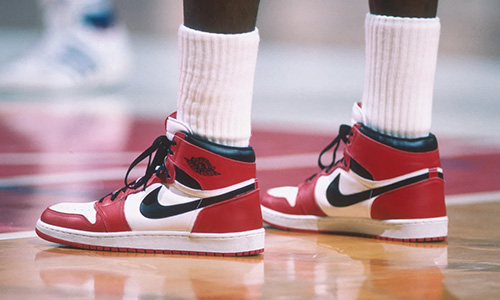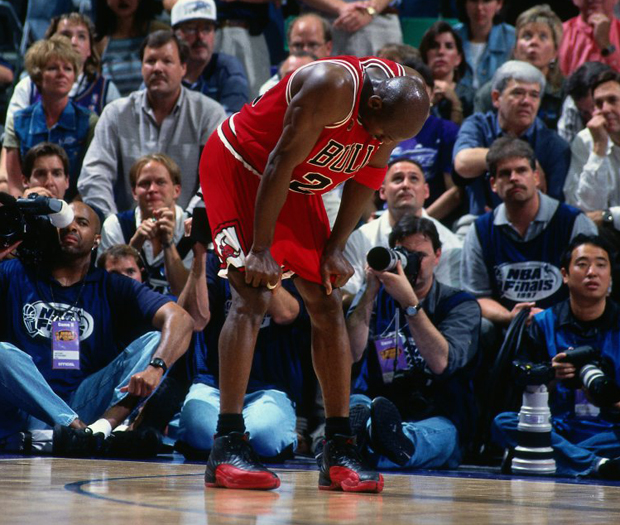The Legendary Beginning
In the early 1980s, as the running shoe trend began to cool down, Nike’s sales started to plummet. Amidst this shift, American basketball was entering its golden age. NBA games, broadcast live on TV, brought the sport closer to a new generation, igniting a powerful passion.
At that time, Adidas and Converse were truly unshakeable forces in the basketball shoe industry. Superstars like Magic Johnson, Larry Bird, Kareem Abdul-Jabbar, one after another, had signed contracts with these established brands. Recognizing the financial difficulty of competing to sign these already famous stars, Nike decided to bet on finding young talents instead. That’s when a phenomenal young man, fresh out of the University of North Carolina, Michael Jordan, became the center of attention.
Although Jordan initially intended to sign with Adidas, Nike made an unbelievable offer: $2.5 million over five years – a colossal sum unprecedented at the time – along with a dedicated shoe line named after him: Air Jordan.
Air Jordan 1: The Opening Shot
Launched in 1985, the first Air Jordans 1 created an unprecedented wave. Its bold black and red design was famously banned by the NBA for not conforming to uniform regulations. Nike cleverly capitalized on this by promoting it with the “Banned” slogan, causing demand to skyrocket.

In its first year, 4 million pairs of 1s were sold, generating $126 million in revenue. From this moment, the Jordan Brand officially took flight.
The 90s: An Empire Forged
Following the groundbreaking Air Jordan 1, the Air Jordan 2 was introduced, aiming for a more refined and luxurious aesthetic. However, Michael Jordan himself wasn’t entirely satisfied with its direction. In a pivotal move, Nike brought in Tinker Hatfield, the talented designer behind the Air Max line, to take over as the lead designer for the Jordan series.
In 1988, the Air Jordan 3 was launched. It featured the first appearance of the Jumpman logo and introduced a visible Air cushioning system in the sole. The design set a new direction for future Jordan models and helped redefine Nike’s approach to basketball footwear.
In the following years, new Jordan versions were continuously released, from the AJ4, AJ5, up to the Jordan 11 and 12s. Notably, the Jordan 12 Flu Game shoe was inspired by the game where MJ scored 38 points in 44 minutes while battling the flu.

In 1997, a historic decision was made: Nike officially spun off the Air Jordan line into Jordan Brand, establishing it as a fully independent entity within the Nike ecosystem. This move was a powerful testament to Air Jordan’s unparalleled standing and influence within the basketball community at the time.
From Court to Cultural Icon
In 2003, as Michael Jordan officially retired from professional basketball, Jordan Brand found itself at a crossroads within the performance basketball market. Recognizing the need for a bold new direction, the brand’s leadership made a strategic, yet audacious, move: to transcend the boundaries of a pure basketball shoe and aim for broader cultural influence.
This marked the beginning of Jordan Brand’s relentless pursuit of collaborations. They began partnering with influential brands, artists, and celebrities, consistently releasing highly sought-after collaborative sneakers. Legendary names like Undefeated x Air Jordan 4, Eminem x Carhartt x Air Jordan 4 and Travis Scott x Air Jordan 1 High “Mocha” not only reinvigorated the brand but also firmly cemented Jordan’s place in the broader landscape of fashion, music, and streetwear. These partnerships successfully transformed the Air Jordan from merely a performance shoe into a global cultural phenomenon.

Legacy and Future
Even decades after Michael Jordan’s final retirement, his name and the Jordan Brand remain as prominent as ever. The continuous re-release of beloved Retro models consistently captivates both new generations of fans and nostalgic enthusiasts, bridging the gap between historical appeal and contemporary trends.
Today, Jordan Brand stands as a multi-billion dollar global empire. The brand continues to expand its reach, venturing into women’s and children’s footwear, athletic apparel, and even high-end lifestyle collections, solidifying its position as a powerhouse far beyond the basketball court.
Conclusion
From a daring contract with a 21-year-old phenom in 1984, Jordan has evolved into a global fashion empire. The brand’s history is not just about the shoes; it’s a testament to how one individual’s impact can profoundly reshape popular culture.
If you’re looking to own legendary Jordan sneakers with high quality at an accessible price, at Sneakerdaily, we offer UA Jordan versions – utilizing the same materials as the original releases, allowing you to indulge your passion without breaking the bank.
Order today and experience the quality and prestige of Jordan – your way.

